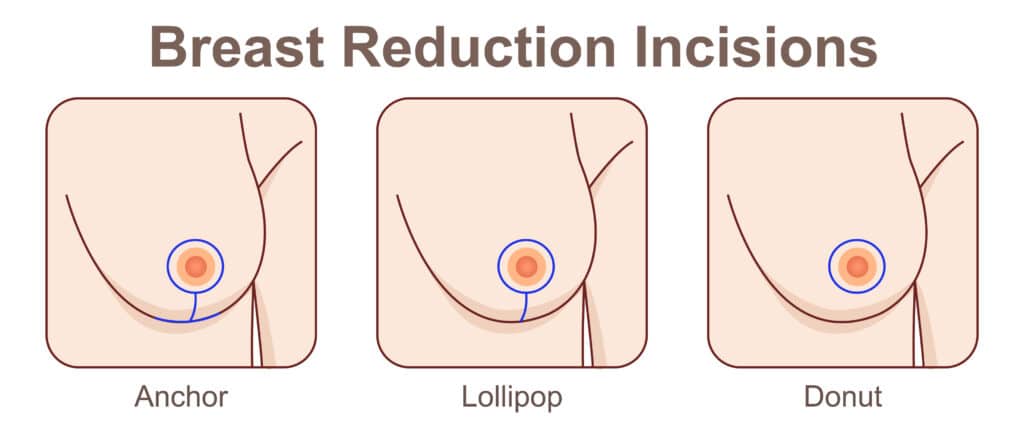Breast reduction surgery is one of the most popular elective surgery options in the world. It increased in popularity by almost 42% between 2015 and 2019.1 In 2020 alone, more than 33,000 people had an aesthetic breast reduction.2
A breast reduction procedure, known clinically as reduction mammoplasty, permanently reduces breast size in people whose breasts are done growing. A surgeon removes excess fat, tissue, and skin to achieve a more comfortable breast shape.3
The breast reduction before and after picture can be life-changing. If you’re tired of dealing with uncomfortably large breasts, read on to learn what this procedure is like from pre- to post-op.
Why Have Breast Reduction Surgery?
Breast reduction surgery is usually a response to the discomfort, inconvenience, and even pain of having large breasts. The procedure alleviates multiple kinds of physical and emotional distress, including:
- Chronic neck, back, shoulder, and nerve pain due to breast weight
- Skin irritation or rash under the breasts
- Inability to participate in certain activities, especially athletics
- Difficulty finding bras, tops, and dresses that fit
- Self-consciousness and social challenges
- Poor self-image
Breast reduction surgery is a valid choice whether or not you have physical discomfort related to your breast size. Your first step is to visit a surgeon and find out if you’re a candidate.
What to Expect as a Patient
Breast reduction surgery is an option for patients of all ages, from teenagers to older adults, though some young patients choose to wait until their breasts are done growing. A plastic surgeon can walk you through everything you need to know as a potential candidate, but here’s an overview to get you started.
Before the Surgery
To decide whether breast reduction surgery is right for you, a plastic surgeon will meet with you and discuss your goals and concerns related to breast size.
Your surgeon will also review your medical history and health to ensure the procedure is safe. Some patients who are obese or have certain medical conditions like heart disease or diabetes may not be good candidates.
If you qualify for breast reduction, your surgeon will examine, measure, and photograph your breasts as preparation for the surgery. They’ll also discuss the details of the procedure and what recovery will look like.
Steps of the Procedure
Breast reduction is a straightforward and routine procedure. Most patients tolerate it well and don’t need to stay overnight in a hospital.5 Your surgeon will make the final call that’s safest for you.
1. Anesthesia
Surgeons have two options for making you comfortable during your procedure:
- General anesthesia: You’re fully unconscious and unaware of the procedure
- IV sedation: You receive intravenous medication that relaxes you, makes you drowsy, and may cause you to fall asleep during the procedure4
If you and your surgeon choose IV sedation, you’ll also receive a local or regional anesthetic so you don’t feel anything during the surgery.6 Depending on the level of sedation your surgical team chooses, you may not remember the event.
2. Incision
The surgeon will access the breast tissue, making incisions around the areolae — the circular area of darker skin surrounding the nipple. There are three types of incisions:
- A full circle around the areola
- Keyhole: A circle around the areola and a line down to the breast crease, also called a vertical or lollipop incision
- Anchor: Similar to the keyhole, but with a third incision along the breast crease7
The anchor is one of the most popular methods, especially with patients who need significant tissue removal.

3. Removal and repositioning of tissue
The surgeon will remove breast tissue to achieve the patient’s desired size. They will then reshape the breast, aiming for as much symmetry as possible.
In most cases, the nipple remains connected to its nerve and blood supply throughout the procedure. However, if the breasts are extremely large, the surgeon may need to remove the areola and nipple to reposition them higher on the breast.
4. Closing
The surgeon will end the procedure by closing the incisions with sutures, adhesives, or surgical tape. You’ll probably have bandages or a gauze dressing over your breasts.
Your surgeon may also place a drain under one or both arms to prevent fluid buildup. This is more common in patients over 50 and those who need a larger volume of tissue removed.8
The Recovery Process
Expect to feel some tenderness, swelling, and bruising for a few days to a few weeks after surgery. You might receive prescription medication to help with pain and prevent infection.
Your surgeon will probably recommend that you avoid intense activity for two to four weeks. You may also need to wear a compression bra to protect your chest.
Breast Reduction: What to Expect Before and After
The “before” of breast reduction is very individual. Many people arrive at the surgeon’s office with disproportionately large or asymmetrical breasts. Whether your breasts are “too big” is entirely a matter of your own preferences.
So is the “right size” you hope for after surgery. You and your surgeon will set a target size and shape, and you’ll start to see results immediately after surgery. Your breasts will take on their long-term size and shape as your swelling goes down. If you lose significant weight, your breast size may change further.
Incision lines will be visible for a while after the surgery. Scars usually fade over time and are covered by a bra or bathing suit.
First Steps to Breast Reduction Surgery
If you’ve decided to pursue breast reduction, your first step is to find a qualified surgeon in your area. If you’re based in the U.S., look for a surgeon with board certification from the American Board of Plastic Surgeons® (ASPS).9 Use the ASPS surgeon search tool to find a qualified professional in your area or ask your primary care physician for a recommendation.
Your primary doctor can also help you determine whether insurance might cover your surgery. Insurance companies usually assume breast reduction to be “cosmetic” — and thus not covered — unless you can demonstrate a medical need.10 That usually means showing proof of pain or loss of function, along with records of non-surgical attempts to correct the problem. Contact your insurance company for more details.
Whether you pay out of pocket or receive insurance coverage, breast reduction surgery can make your life easier and more comfortable. Talk to a surgeon today or search for more resources on My Body Treatment.
SOURCES:
- International Society of Aesthetic Plastic Surgery: ” ISAPS INTERNATIONAL SURVEY ON AESTHETIC/COSMETIC PROCEDURES (2019).”
- American Society of Plastic Surgeons: ” Plastic Surgery Statistics Report.”
- American Society of Plastic Surgeons: ” Breast Reduction.”
- American Society of Anesthesiologists: ” IV/Monitored Sedation.”
- American Society of Plastic Surgeons: ” Breast reduction takes a load off your back.”
- Brigham and Women’s Hospital: ” Anesthetic Options for Breast Surgery.”
- American Board of Cosmetic Surgery: ” Breast Reduction Guide.”
- Annals of Plastic Surgery: ” When to use drains in breast reduction surgery?“
- American Society of Plastic Surgeons: ” How do I choose a plastic surgeon for breast reduction surgery?“
- American Society of Plastic Surgeons: ” Is breast reduction covered by health insurance?“





